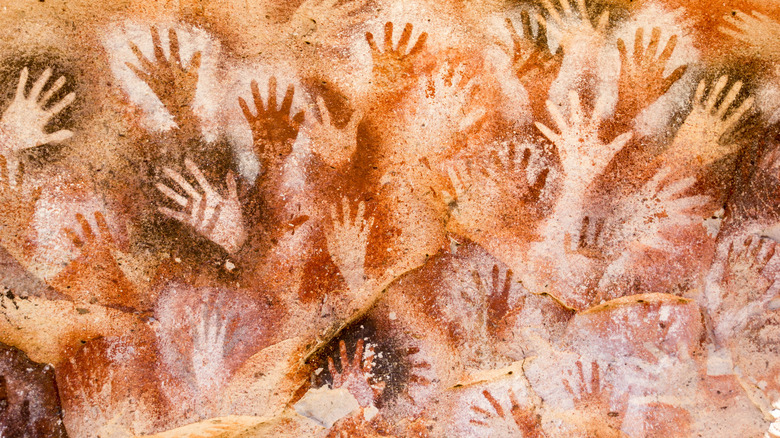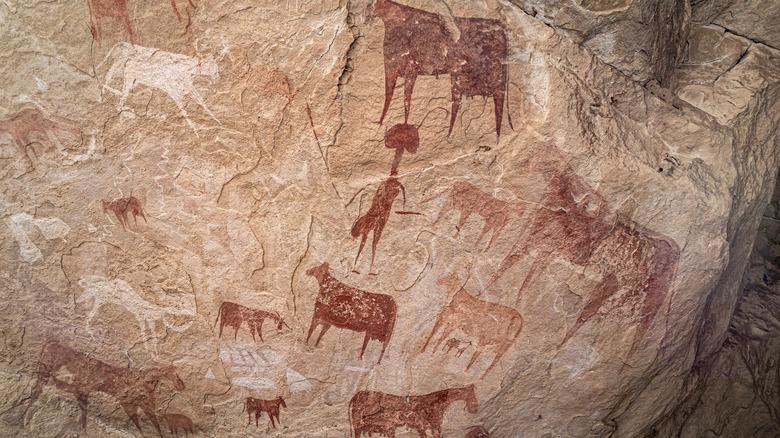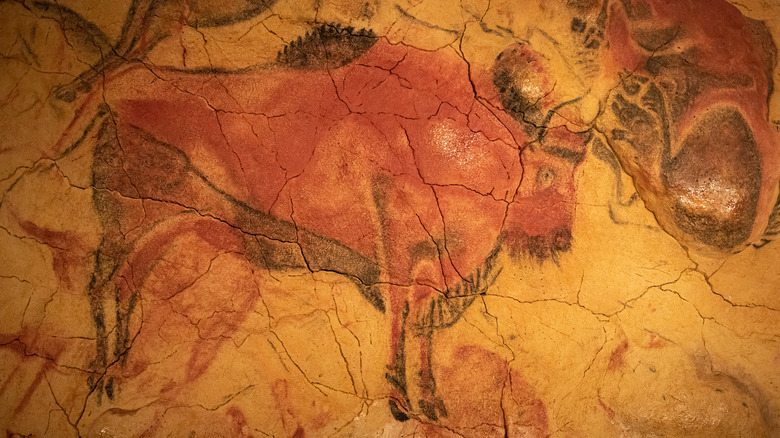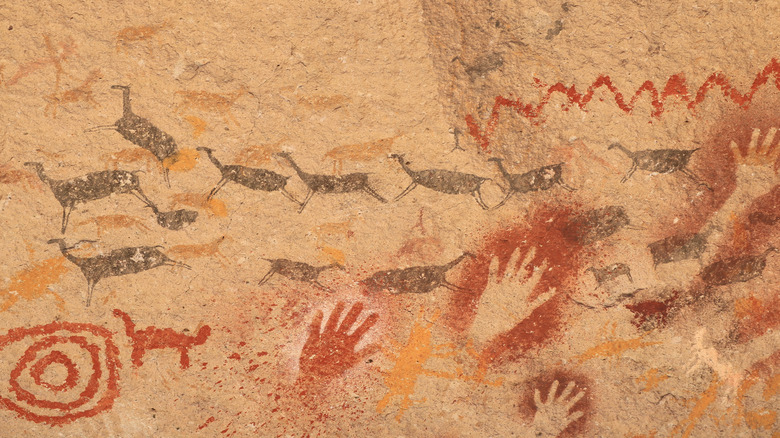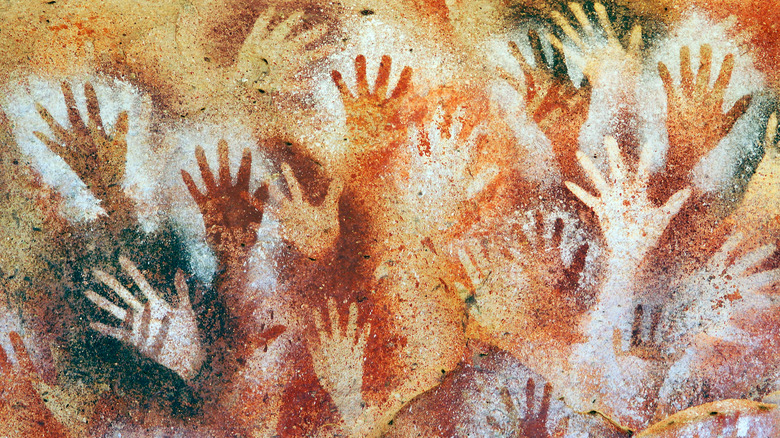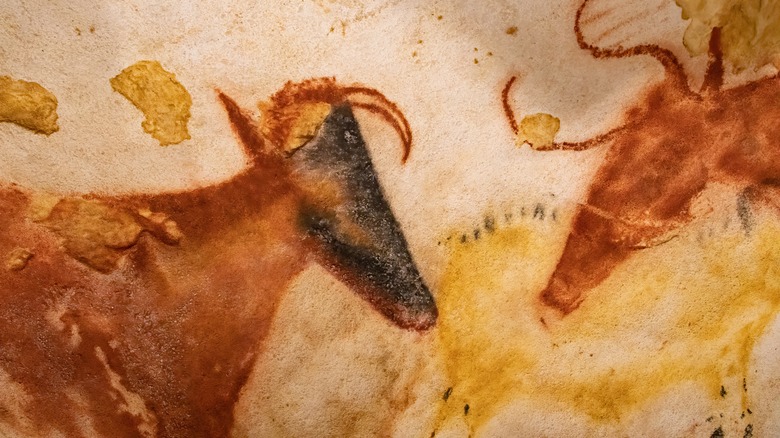What Was Used As Paint In Cave Paintings?
For almost as long as we could walk, humans have been making art. Ancient art took on a variety of forms: small clay sculptures like the curvy Venus of Willendorf (per Britannica), elaborate jewelry made from beads and shells, and much more. But among the oldest and most universal forms of art are cave paintings.
According to American Scientist, cave paintings have been found on every continent on Earth. (Besides Antarctica, that is — penguins aren't able to wield paintbrushes just yet.) These cave paintings vary greatly in their age and location, but they tend to share similar subject matter. For example, one of the oldest known cave paintings — dated to over 45,000 years ago, per The Guardian — was found in Indonesia, and depicts a life-sized image of a wild pig (with exaggeratedly tiny limbs) flanked by two human hand outlines. Cave art found in Spain, made by our cousins the Neanderthals, may be even older; these cave paintings also depict animal figures and hand prints, along with some more abstract shapes, National Geographic reports.
Figures of animals, figures of humans, and hand outlines seem to have dominated the ancient art world. These depictions have been found in cave paintings from India to France to Somalia to Argentina, writes Touropia. If you've seen these ancient artworks, in photos or in person, you've probably been stunned by their timeless beauty. Given that awe-struck feeling, you may not have taken a step back to ask a more basic question: Just how were these paintings made?
Ancient paints mostly came from minerals, not plants or animals
Obviously, ancient humans couldn't pop into the local hardware store to buy cans of paint. They had to craft their own paint using the materials they had on hand.
If you had to guess what those materials might be, you might initially point to organic (i.e. living) sources like plants and animals. Maybe our ancestors made paint from colorful flowers? Or perhaps from animal blood? According to Pigments Through the Ages, ancient humans did use organic materials to make dyes — such as dyes for their clothing. But our cave-dwelling ancestors soon discovered that plant- and animal-based pigments don't work well as paints. When stuck against a wall, organic substances are rarely very vibrant, and they tend to fade away quickly. Instead, our ancestors generally made paints out of inorganic substances — minerals, most commonly.
That's not to say that organic substances played no role in the process. Pigments Through the Ages points out that ancient people commonly mixed minerals with spit and animal fat — those latter substances serving as the "binding media" that helped the paint stick to the wall. Furthermore, a variety of organic materials served as "paintbrushes," including moss, sticks, and feathers. (Certain elite artists even had brushes made from horsehair.) Plus, in some instances, organic materials were used as paints. As one example, the 5,000-year-old paintings in Bulgaria's Magura Cave are made from guano — bat poop, Touropia writes.
Black paints were often made from charcoal, and reds came from ochre
Still, minerals served as the basis of most prehistoric paints. For any given color, there were generally a few minerals that our ancestors preferred — valuing them for their specific shade, or simply for their ease-of-access.
According to the Royal Society of Chemistry (RSC), two colors appear most frequently in ancient cave art: black and red. Black pigments were made in a few different ways. Per the RSC, ancient humans frequently made black paint from charcoal, which is the mineral form of carbon that you get from burning wood. Besides charcoal, black pigments could be made from other forms of burnt residue. For example, Pigments Through the Ages points to a specific shade known as "bone black" produced solely through the burning of bones or ivory. Black paint could also be produced from manganese oxide, which is obtainable in its mineral form as an ore called pyrolusite.
For red paint, the RSC continues, the most common color source was ochre. Ochre is a pigment made from iron oxide (which can be found in minerals like haematite and limonite) mixed together with varying amounts of clay and sand. If you've ever seen rust, you've seen iron oxide, so you can probably appreciate its rich red color. Ochre wasn't the only source of red at our ancestors' disposal — certain aluminum-based minerals also worked — but it definitely seems to be the most prominent.
Mineral pigments were mixed into paints — some liquid, some not
While red and black were the most common colors in cave paintings, they weren't the only pigments that our ancestors produced. White was another; as the RSC writes, white paint was made from limestone, from the crystalline mineral "calcite," or from crushed shells — all of which are rich in calcium carbonate, a substance which is naturally white. Yellow, like red, was typically made from ochre — but an ochre made from the mineral limonite instead of rust-colored haematite. Brown was obtained from the mineral manganite.
It's worth noting that these prehistoric "paints" are hardly like the smooth liquid paints we have today. According to Pigments Through the Ages, some ancient paints were in liquid form, but with a consistency more like paste. Besides these pasty paints, our ancestors also drew on cave walls with materials more akin to crayons. Ochre, for example, is made from clay, so it was easy for ancient humans to mold ochre into crayon-like sticks and draw pictures with them.
Our ancestors made a variety of paints in a variety of ways. But, per the RSC, the typical paint-making method followed a few key steps: Obtain a colored mineral, grind it into a powder, then mix it with a binding substance (like the spit and fat we mentioned before) and an "extender" fluid to increase the overall volume of the mixture.
Ancient humans had difficulty producing colors like blue and green
Red, black, a bit of white, and a splash of yellow or brown: these are the colors you can expect to see most often in ancient cave paintings. The Indonesian pig drawing we mentioned earlier was made using dark red ochre, The Guardian reports. Argentina's famous "Cave of the Hands" depicts human hands outlined in red, black, white, and yellow — each color produced from a different mineral, Atlas Obscura writes. (Notably, that cave mostly shows left hands; per Patagonline, each artist probably pressed their left hand against the cave wall while holding a hollow bone tube in their right hand, then proceeded to blow pigment onto their left hand through the tube.)
Colors besides red, black, white, yellow, and brown are exceedingly rare. For most other colors, that makes sense; minerals found in the earth tend to mostly come in "Earth tones," not pinks and purples. Not blues, either; the RSC notes that blue minerals, like azurite and lazurite, are quite rare.
The absence of green is harder to account for. According to the RSC, green minerals — like malachite and the mineral-based pigment "terre verte" — are in fairly large supply. Why these pigments were hardly used is unclear. Maybe green just didn't look very bright or attractive when painted on the wall of a dark cave, the RSC speculates. (Or maybe the color just took several millennia to come into fashion.)
Making the right pigments required travel and trade
As you can see, ancient humans put a lot of effort into paint-making. Of course, our ancestors had little to no understanding of the chemical properties of the materials they were working with; the process of turning minerals into usable pigments was surely more based in trial-and-error than exact science. (In a sense, that makes their artistry even more impressive.)
Maybe this paint-making process sounds like a trivial pursuit — something the laziest cave folk did while the others were out hunting. But, in actuality, it seems that painting was of great importance to humans around the ancient world. According to the RSC, researchers have found many examples of cave walls that were painted using mineral-derived pigments where the minerals don't naturally occur anywhere nearby the cave itself. This suggests that some ancient humans traveled great distances to obtain the minerals they needed for paints, or that these minerals were shipped over vast distances along trade routes.
Whether ancient humans traded for it or mined it themselves, obtaining the right minerals clearly required a lot of time and resources. This suggests that our ancestors took cave art very seriously — perhaps as a ritual practice dedicated to safety, fertility, and a successful hunt (as HeadStuff suggests), or simply because they valued creative expression. The results of their artistic efforts have, in many cases, lasted on cave walls for tens of thousands of years — a stunning legacy to leave behind for their descendants.
